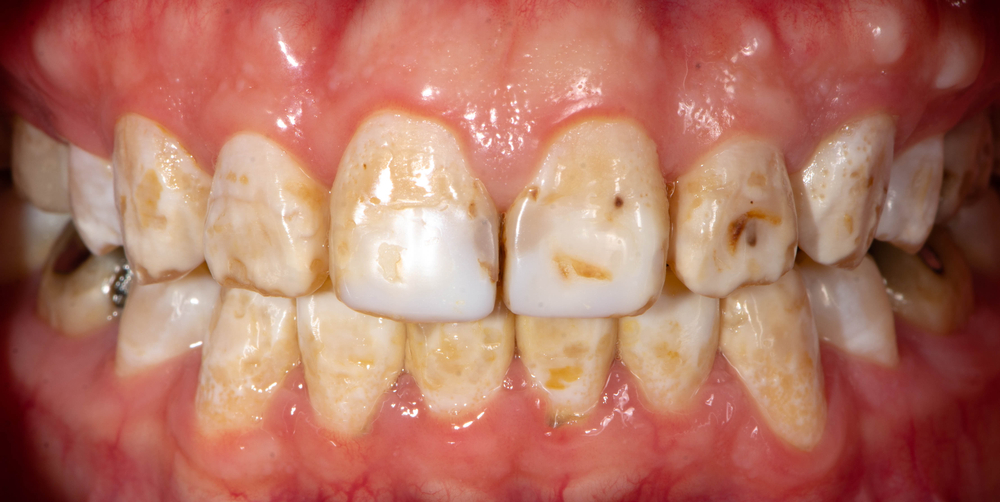Fluoride, a naturally occurring mineral, is found in varying quantities in the earth’s crust, water, and various foods. For decades, it has been celebrated for its dental benefits, specifically its role in preventing tooth decay. Fluoride achieves this by reinforcing the mineral structure of teeth, making them more resistant to acidic attacks by bacteria. This mineral, when harnessed at the right concentrations, can be a game-changer in oral health. Many countries have even adopted water fluoridation practices to protect their populations against cavities. However, while fluoride offers undeniable benefits, it is not without controversy and potential risks, especially when consumed in large amounts which can lead to fluoride toxicity.
Acute Poisoning with Fluoride Compounds

Acute fluoride poisoning, often referred to as “fluoride toxicity,” occurs when a person ingests a harmful dose of fluoride in a short period. This can be due to accidental ingestion or exposure to high concentrations of fluoride compounds.
- Definition: Acute fluoride toxicity is characterized by immediate physiological reactions following a large intake of fluoride, either orally or through the skin.
- Sources: Key sources of acute fluoride poisoning can include industrial chemicals, certain rodenticides and insecticides, dental products (especially if consumed in large quantities), and some household cleaning products that contain high fluoride concentrations.
- Historical Incidents: Over the years, there have been instances of acute fluoride poisoning due to industrial accidents. One notable example occurred in Alaska in 1992 when a water pump malfunctioned, leading to a community being exposed to extremely high fluoride levels. Similarly, accidental over-fluoridation of public water supplies has caused community-wide poisoning in the past.
- Toxic Doses: The toxic dose for acute fluoride poisoning in adults is estimated to be between 5-10 grams of fluoride, which equals 32-64 mg of fluoride per kilogram of body weight. For children, the dose can be much lower, given their smaller body size.
- Symptoms: Symptoms of acute fluoride poisoning can range from mild to severe, depending on the amount ingested. They may include nausea, vomiting, diarrhea, abdominal pain, increased salivation, and thirst. In more severe cases, individuals might experience muscle spasms, difficulty breathing, cardiac arrest, and even death. If anyone is suspected of having ingested a large amount of fluoride, seeking immediate medical attention is crucial.
The potential dangers associated with acute fluoride exposure underscore the importance of regulating fluoride levels in public utilities, understanding its sources, and being aware of its symptoms to ensure timely medical intervention.
Chronic Poisoning with Fluoride Compounds

Chronic fluoride poisoning results from long-term exposure to high levels of fluoride, typically over several years. Unlike acute poisoning, which results from a sudden, high-level exposure, chronic poisoning accumulates over time, often with more subtle but lasting effects.
- Sources: Chronic exposure sources include drinking water with naturally high fluoride concentrations, prolonged consumption of fluoride-rich foods, and continuous use of fluoride-rich dental products or medications. In certain regions, naturally occurring fluoride in groundwater can be particularly high, leading to chronic exposure for inhabitants.
- Causes: One of the primary causes of chronic fluoride poisoning is the prolonged consumption of water that exceeds the recommended fluoride levels. Over-reliance on dental products containing fluoride without proper guidance can also be a contributing factor.
- Effects: Chronic fluoride poisoning can have various effects on the human body, some of the most notable being:
- Dental Fluorosis: This is a cosmetic effect, resulting in staining and pitting of the teeth. It arises from excessive fluoride exposure during the formative years of tooth development.
- Skeletal Fluorosis: This condition affects the bones and joints. Early symptoms might be mistaken for arthritis and can progress to debilitating bone deformities in severe cases.
- Impact on Soft Tissues: High fluoride levels can potentially affect soft tissues, leading to symptoms such as muscle weakness or gastrointestinal issues.
Dental and Skeletal Fluorosis
- Dental Fluorosis: Dental fluorosis is the appearance of faint white lines or streaks on the teeth that only occurs when younger children consume too much fluoride, from any source, over long periods when teeth are developing under the gums. Once the teeth emerge through the gums, you cannot develop dental fluorosis. The critical period for exposure is between birth and 8 years. In its mild form, dental fluorosis appears as barely noticeable tiny white spots or streaks on tooth enamel. More severe forms can result in brown stains, pitting, and a mottled appearance.
- Prevention: One can prevent dental fluorosis by ensuring children do not swallow excessive amounts of toothpaste and by monitoring the fluoride levels in drinking water.
- Skeletal Fluorosis: Skeletal fluorosis is a bone disease exclusively caused by excessive consumption of fluoride. In its early stages, symptoms may include stiffness and joint pain. As the disease progresses, it can lead to altered bone structure, calcification of ligaments, and bone spurs. Severe cases can result in limited joint mobility, crippling deformities, and severe pain.
- Prevention: The primary prevention method is ensuring that drinking water sources do not have excessively high levels of fluoride. In areas with naturally high fluoride content in groundwater, using alternate water sources or defluoridation techniques can mitigate the risk.
Both forms of fluorosis underscore the importance of monitoring fluoride intake. While fluoride is beneficial in preventing dental decay, a fine balance is necessary to prevent adverse health outcomes.
Sources of Fluoride: Food

Fluoride can be found naturally in various foods, primarily depending on the fluoride concentration in the soil and water where these foods are grown. Furthermore, the processing of certain foods can introduce fluoride.
- Seafood: Many marine fish have higher fluoride levels, especially if their bones are consumed, like in sardines. Shellfish also tend to have elevated fluoride concentrations.
- Tea: The tea plant accumulates fluoride from soil and water. As a result, tea leaves, especially old ones, have high fluoride content. Both black and green teas can contain significant fluoride amounts, but it varies based on factors like where they’re grown and how they’re processed.
- Grapes and Wine: Grapes can absorb fluoride from soil and pesticide residues, making some wines, particularly white varieties, sources of fluoride.
- Processed Foods: Some processed foods might contain higher fluoride levels, particularly if they’re made with fluoridated water or contain other fluoride-rich ingredients.
- Cereals and Grains: These can have variable fluoride content depending on where they are grown and if fluoride pesticides were used.
- Implications: It’s rare for someone to ingest harmful fluoride amounts solely from foods unless they consistently consume large quantities of high-fluoride products. However, understanding the fluoride content in food is essential for individuals in high fluoride regions or those at risk for fluoride-related conditions.
Sources of Fluoride: Water and Drinks

Water is a primary source of fluoride, both naturally occurring and added for dental health benefits.
- Tap Water: Many municipal water supplies have fluoridated water, which means fluoride is intentionally added, usually aiming for a concentration of around 0.7 parts per million (ppm), although this can vary based on the region.
- Natural Spring and Well Water: Some groundwater, especially from deep wells or natural springs, can have high naturally occurring fluoride levels. In certain regions, these levels can be above recommended amounts, leading to potential health risks.
- Bottled Water: The fluoride content in bottled water varies. Some brands have levels similar to tap water, while others might be lower or higher. Labels rarely provide this information, but it’s crucial for consumers who rely heavily on bottled water.
- Soft Drinks and Juices: Beverages made in areas with fluoridated water often contain fluoride. For example, sodas, canned juices, and other commercial beverages might contain varying fluoride amounts, depending on their water source and processing.
- Infant Formula: When mixed with fluoridated water, powdered or liquid concentrate infant formula can be a significant fluoride source.
- Implications: As water is a primary fluoride source for many, it’s crucial to understand local water fluoride levels. This knowledge is especially important for vulnerable populations, such as infants, and those with health conditions that might make them more susceptible to fluoride’s adverse effects.
Remember, while fluoride in moderate amounts is beneficial for dental health, excessive ingestion over extended periods can lead to health issues like dental and skeletal fluorosis.
The Role of Geography and Geology

The presence of fluoride in drinking water isn’t solely a result of human intervention; natural sources can also introduce significant amounts of fluoride. The geology of an area plays a crucial role in determining the fluoride concentration in its groundwater.
- Natural Rock Formations: Certain rock formations release fluoride when they come into contact with water. These include cryolite, fluorapatite, and fluorite. Regions with abundant amounts of these minerals in the bedrock can have high fluoride concentrations in groundwater.
- Volcanic Activities: Areas with active volcanism might have elevated fluoride levels in local water sources due to the emission of fluoride-rich gases and ash.
- Highly Alkaline Groundwater: In areas with alkaline groundwater (high pH), there’s a higher likelihood of fluoride leaching from the surrounding rocks into the water.
- Impact of Climate: In arid regions, high evaporation rates can lead to the concentration of minerals, including fluoride, in water sources.
- Regions of Concern: Parts of East Africa (like the Rift Valley), India, and China have naturally high fluoride levels in groundwater, leading to health challenges for local populations.
- Implications: Understanding the geography and geology of an area can provide insights into potential fluoride risks. It helps in implementing necessary interventions, such as the introduction of defluoridation techniques or alternative water sources.
Fluoride in Daily Products

Fluoride isn’t just found in food and water; it’s also a key ingredient in various daily-use products, primarily aimed at promoting dental health.
- Toothpaste: The most well-known source of topical fluoride. Most toothpastes on the market contain fluoride, usually in the form of sodium fluoride. The concentration varies, but adults’ toothpaste typically contains between 1,000 to 1,500 ppm of fluoride.
- Mouthwash: Many mouthwashes contain fluoride, especially those designed for cavity prevention. They are not intended for ingestion and should be spat out after use.
- Fluoride Gels and Varnishes: Dental professionals might apply these products during dental check-ups. They provide a higher fluoride concentration to strengthen tooth enamel and combat cavities.
- Teflon-coated Cookware: Pots and pans coated with Teflon might release trace amounts of fluoride, especially when they’re old or damaged.
- Certain Medications: Some medications contain fluoride, though the amounts are generally small and not a significant source of daily intake.
- Implications: It’s essential to be aware of the cumulative fluoride exposure from multiple sources in daily life. Especially for children, who are more prone to swallowing toothpaste, parents should monitor and ensure they use an age-appropriate pea-sized amount to minimize ingestion risks.
Understanding the different sources of fluoride exposure helps individuals make informed choices about their health and the health of their families.
Managing Fluoride Intake
Given the wide array of sources from which individuals can be exposed to fluoride, managing its intake becomes imperative, especially in areas with naturally high concentrations in water or for those who consume products with added fluoride.
- Water Defluoridation: For areas with naturally high fluoride levels in water, defluoridation methods, such as activated alumina filters, bone char, and reverse osmosis, can be used. Some regions also use community-level defluoridation plants to serve larger populations.
- Alternative Water Sources: In regions where the groundwater has excessive fluoride, utilizing surface water sources like rivers or lakes can be a viable alternative.
- Dietary Choices: Being aware of the fluoride content in food and drinks helps individuals adjust their intake. For instance, if one lives in an area with fluoridated water, reducing consumption of fluoride-rich foods can help balance the overall intake.
- Dental Products: Use toothpaste with appropriate fluoride concentrations based on age and individual needs. Children, especially, should be supervised when brushing to ensure they don’t swallow toothpaste.
- Regular Testing: Especially in areas known for high fluoride content in groundwater, regular testing of water sources can help monitor and manage fluoride levels.
Conclusion: Balancing Fluoride for Health
Fluoride has played a substantial role in dental health by significantly reducing the prevalence of dental caries. However, like many elements vital for our health, its benefits are most pronounced when present in the right amounts. Too little can lead to dental issues, while too much can result in a range of health problems.
It’s crucial to understand that fluoride, in optimal amounts, is beneficial, but its excessive intake, either due to natural sources or human-made products, can be detrimental. This balance is especially important for vulnerable groups like children, who are more susceptible to the effects of both fluoride deficiency and excess.
As with many health-related issues, awareness is paramount. Knowledge of the various sources of fluoride, its benefits, and its potential risks helps individuals and communities make informed decisions. By testing water sources, making informed dietary choices, and using dental products responsibly, one can harness the benefits of fluoride while minimizing its potential downsides.
In the quest for better dental and overall health, striking the right balance with fluoride becomes an essential task, showcasing the intricate relationship between humans, the environment, and the compounds we interact with daily.
Further Reading
This article is the second of four articles in our Fluoride Series. It was adapted and written from the following article, published in Materials in February, 2023:
The Safety of Fluoride Compounds and Their Effect on the Human Body—A Narrative Review






